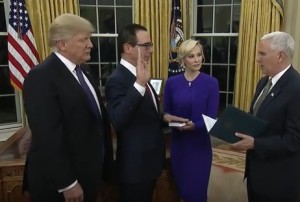By Pam Martens and Russ Martens: January 30, 2018

Vice President Mike Pence Swears In Steven Mnuchin as U.S. Treasury Secretary on February 13, 2017. President Donald Trump and Mnuchin’s Fiancée, Louise Linton, Look On. Mnuchin Wiill Have to Deal This Year With a Likely Doubling of U.S. Treasury Net Issuance.
The benchmark 10-year U.S. Treasury yield touched 2.7 percent on Monday and as of 8:16 a.m. this morning it has returned to that level. The sharp rise in Treasury yields produced a 177 point drop in the Dow Jones Industrial Average yesterday. As of 10:07 a.m. this morning, the Dow had lost an additional 334 points. Many market watchers see even more dangerous headwinds for the stock market if the 10-year Treasury reaches a 3 percent yield. (See our analysis: Rising Treasury Yields Pose Risk for Those Over-Weighted in Stocks.)
The recent market action suggests that investors are about to get a serious investing lesson in the concept of supply and demand. According to research from the major Wall Street banks, there is going to be a stunning doubling of the net issuance of U.S. Treasury securities in the current Federal fiscal year versus last year. Net issuance of Treasuries in the last fiscal year was approximately $500 billion. For the coming year, Goldman Sachs projects the amount will be $1.03 trillion; Deutsche Bank thinks it will be about $1 trillion while JPMorgan Chase is floating the breathtaking figure of $1.42 trillion.
The huge increase comes from two primary factors: a mushrooming budget deficit from the recently passed tax cuts and the wind down by the Federal Reserve of its Treasury purchases.
Until last October, the Federal Reserve was sopping up Treasury issuance by rolling over all of its maturing holdings of Treasuries into newly issued Treasuries. The Federal Reserve is now in the runoff mode in order to “normalize” its balance sheet from its Quantitative Easing (QE) days during the financial crisis when it purchased more than $3 trillion of Treasuries and mortgage-backed bonds.
The first Fed runoff came in October of last year with the Fed shrinking the amount of maturing Treasury principal it was rolling over into new Treasuries by $6 billion a month. According to its preset schedule, that figure was boosted to $12 billion this month. The shrinkage amount will grow gradually until October of this year when the Fed will roll over $30 billion less each month in Treasuries going forward than it had in prior years. (The Fed also acquired huge holdings in mortgage-backed bonds during the financial crisis and it is trimming its rollover of maturing principal in those as well.)
To summarize, Treasury supply is going to double while one major buyer, the Fed, is ratcheting down its purchases.
Then there is the foreign central bank wild card in the face of the U.S. losing credibility around the world as a result of President Donald Trump’s scandals du jour. According to the latest report from the Government Accountability Office, foreign ownership of Treasuries accounts for 43 percent of Treasuries in the hands of the public. The GAO writes:
“As we have noted in previous years, Treasury reporting shows that foreign ownership of Treasury securities represents a significant portion of debt held by the public. As of June 30, 2017, the reported amount of Treasury securities held by foreign and international investors represented an estimated 43 percent of debt held by the public. This percentage is close to the 45 percent of debt held by the public as of June 30, 2016, but considerably higher than the estimated 30 percent of debt held by the public as of June 30, 2001. Treasury estimated that the amount of Treasury securities held by foreign and international investors has increased from $983 billion as of June 30, 2001, to $6,171 billion as of June 30, 2017 — an increase of $5,188 billion.”
In a note to investors last November, economists at Wells Fargo summarized the situation as follows:
“The Federal Reserve is effectively becoming a net seller of Treasury debt as it shrinks its balance sheet, and foreign central banks probably will not purchase as many Treasury bills, notes and bonds as they did during the past decade. If demand for Treasury securities falls short of supply at current prices, then yields will need to rise to clear the market. Indeed, we look for yields on Treasury debt to rise in the next two years.”

